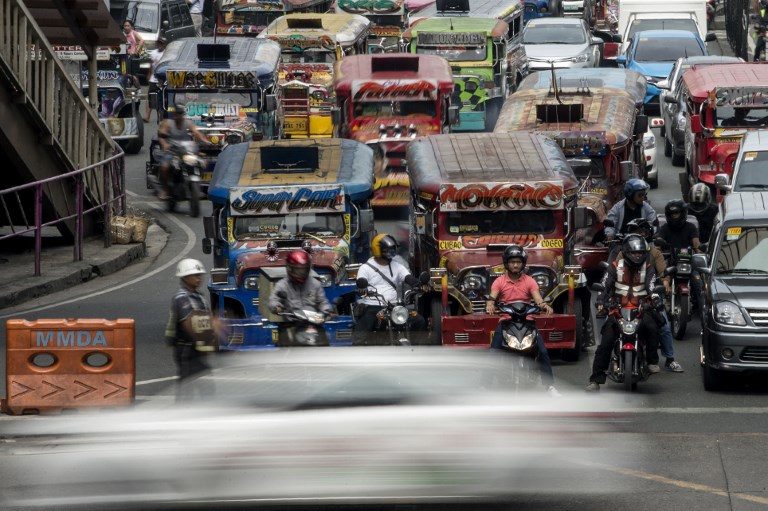SUMMARY
This is AI generated summarization, which may have errors. For context, always refer to the full article.

MANILA, Philippines – Classes were suspended and government work cancelled nationwide on Monday, October 16, as transport groups launched a two-day strike to protest the government’s jeepney modernization program.
It’s the third nationwide strike against the Public Utility Vehicle (PUV) Modernization Program, with the last two strikes held in September and February this year.
While the plan to upgrade old jeepneys had been considered in 2016, it wasn’t until earlier this year that the details of the plan were fleshed out.
What’s the program about?
In June, the Department of Transportation (DOTr) launched the program, which will mandate the phaseout of PUVs aged 15 years or older.
To promote safer and more environmentally-friendly transport options, jeepneys should be replaced by those powered by Euro 4 engines or electrically-powered engines with solar panels for roofs.
There are also proposals to have PUVs outfitted with additional features such as speed limiters, a GPS navigation system, dashboard cameras, an automated fare collection system, Wi-FI, and closed-circuit television cameras.
Also part of the modernization program is a change in the franchising system, updates on new routes, and training for drivers.
The government is eyeing to have modernized buses, jeepneys, and public utility vans across the country by 2020.
Around 180,000 jeepneys will need to be replaced, according to the Land Transportation Franchising and Regulatory Board.
Why are transport groups opposing it?
Transport groups such as the Pinagkaisang Samahan ng mga Tsuper at Operator Nationwide (Piston) and Stop and Go Coalition have called the plan “anti-poor“, saying a brand new jeepney would cost at least P1 million per unit, and would be financially impossible for drivers.
While leftist group Bagong Alyansang Makabayan (Bayan) acknowledged the need to improve the quality of PUVs, it said the phaseout program would lead to a loss of livelihood for drivers and operators.
It also said that only large companies with millions of pesos in capital can afford the proposed “fleet management system” that sets a minimum of 10 units per franchise.
How will the government implement this?
To help PUV operators upgrade to newer jeepneys, the DOTr in September signed a memorandum of understanding (MOU) with the Development Bank of the Philippines (DBP) for a P1.5-billion loan facility for PUV cooperatives.
The DBP will provide loans to cooperatives to finance the acquisition of new jeepneys.
The DOTr also signed an MOU with the Land Bank of the Philippines last April for a P1-billion financing scheme for individual jeepney operators.
In a statement on Sunday, October 16, the DOTr refuted claims that the modernization program was “anti-poor”, pointing out that the financial loan scheme is a major component of the program to help drivers replace their old vehicles.
“The financing package for acquisition of new units endorsed by the Department of Finance (DOF) is very generous – as low as 5% equity, 6% interest rate, and a repayment period as long as 7 years. On top of this, government will offer as high as P80,000 subsidy per unit to cover the equity payment,” the DOTr said.
“All business models based on actual studies ensure profitability [for] the drivers or operators, even if they avail of the financial loan package offered by government financial institutions,” the DOTr added. – Rappler.com
Add a comment
How does this make you feel?
There are no comments yet. Add your comment to start the conversation.